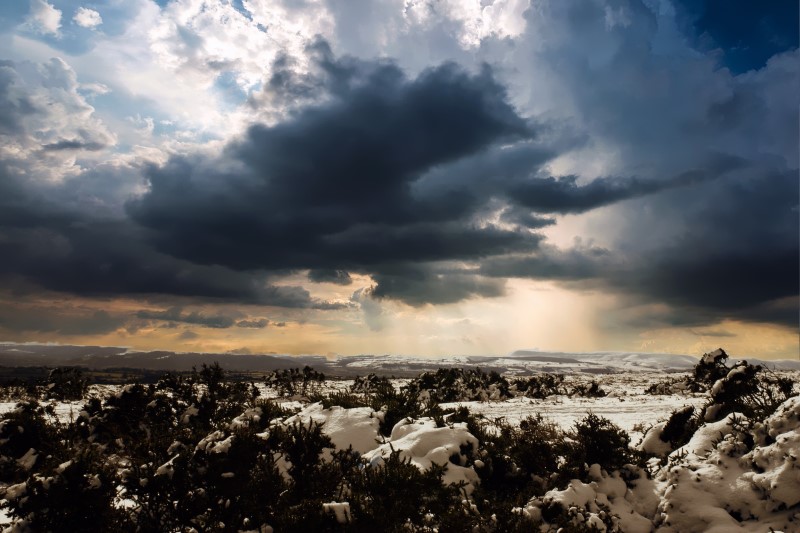Atmospher Sci & Global Chg
Research Highlights
October 2018
Atmosphere Outpaces Ocean in Driving Extreme Winter Weather along the U.S. West Coast
Researchers found that sea surface temperature, the more predictable element of the climate system, accounts for only 20 percent of extreme precipitation variability along the U.S. West Coast.

Atmospheric dynamics account for 80 percent of variances in winter precipitation on the U.S. West Coast, while sea surface temperature contributes 20 percent. Enlarge Image.
The Science
Historical records show the U.S. West Coast exhibits a wide range of extreme precipitation during the winter. Understanding the large-scale environmental influences—or forcing—that contribute to this variability is important for improving predictions of regional climate. Scientists at the U.S. Department of Energy's Pacific Northwest National Laboratory led a study to investigate the relative contributions of sea surface temperature (SST) and atmospheric dynamics to the year-to-year variability of extreme precipitation over the U.S. West Coast. They found that SST forcing accounted for only about 20 percent of the variances of winter extreme precipitation. The remaining 80 percent of extreme precipitation variations were associated with atmospheric dynamics, which are harder to predict than the slowly evolving SST.
The Impact
Extreme precipitation poses significant risks to human life and property, and challenges water management by causing flooding, landslides, and related hazards. Along the U.S. West Coast, extreme precipitation is marked by significant variability that is not fully understood or adequately simulated by models. This study ruled out SST forcing in favor of difficult-to-predict atmospheric variability as the primary influence on year-to-year winter extreme precipitation along the U.S. West Coast. Applied to the winter of 2016–17, the results suggest limited predictability for the multiple landfalling atmospheric rivers and the extreme precipitation that battered California.
Summary
To explore the relative roles of SST forcing versus atmospheric variability in the year-to-year variation of winter extreme precipitation along the U.S. West Coast, researchers analyzed observations, reanalysis products, and 54 Atmospheric Model Intercomparison Project (AMIP) runs from the Coupled Model Intercomparison Project version 5 archive. Focusing on the large-scale environment favoring extreme precipitation, researchers found that SST forcing only accounted for about 20 percent of the variances of winter extreme and non-extreme precipitation. Under SST forcing, extreme precipitation was associated with the Pacific-North American teleconnection, one of the most recognized atmospheric teleconnections in the Northern Hemisphere and responsible for large cyclonic circulation over the North Pacific. Meanwhile, non-extreme precipitation was associated with the North Pacific Oscillation, a northeast-southwest seesaw pattern of sea level pressure in the North Pacific.
On the other hand, atmospheric variability was shown to dominate the variability of winter extreme precipitation, featuring a circumglobal waveguide pattern. This quasi-stationary wave feature reflects the intrinsic variability of the mid- to high-latitude atmosphere and it can interact with above- or below-normal convection over the tropical western Pacific. Whether forced by SST or atmospheric dynamics, this study identified atmospheric rivers as a common and indispensable feature of the large-scale environment, enhancing water vapor transport that produces concomitant extreme precipitation along the U.S. West Coast.
Researchers applied their findings to the winter of 2016-17 when multiple atmospheric rivers made landfall in California, causing record extreme precipitation. The results suggested those record conditions were more likely the result of atmospheric variability associated with anomalous convection over the Maritime Continent rather than tropical SST forcing. Overall, the study points to the challenge of predicting extreme precipitation on the U.S. West Coast because SST, which changes slowly over time and is therefore more predictable, plays a relatively minor role compared to atmospheric variability.
Acknowledgments
Sponsors: This research is supported by the U.S. Department of Energy Office of Science Biological and Environmental Research as part of the Regional and Global Climate Modeling and Multi-Sector Dynamics, Earth and Environmental System Modeling programs.
Research Area: Climate and Earth Systems Science
Research Team: Lu Dong, Lai-yung Ruby Leung, Fengfei Song, and Jian Lu
Reference: L Dong, LR Leung, FF Song, and J Lu, 2018. "Roles of SST versus internal atmospheric variability in winter extreme precipitation along the U.S. West Coast." Journal of Climate 31, 8039-8058 (2018). [http://doi.org/10.1175/jcli-d-18-0062.1.]
